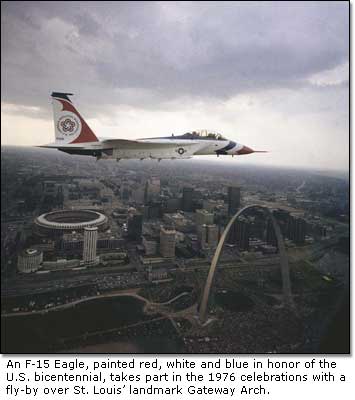
 |
October 2004 |
||||
Volume 03, Issue
6 |
|||||
| Main Feature |
 65
years of SPIRIT 65
years of SPIRITBoeing St. Louis celebrates rich aerospace history BY MADONNA WALSH AND LARRY MERRITT Separated by 17 years in age and thousands of miles, William Boeing, James McDonnell and Donald Douglas shared the same belief in the future of aviation. Today, the spirit, the dedication and the drive for excellence of all three men continue to guide the people of Boeing St. Louis as they celebrate the 65th anniversary of the site. "I started here in 1978, and I've always felt a part of something special," said Bruce Scheidhauer, senior manager, Tactical Aircraft Product Definition Integration. Scheidhauer's experience includes work on the F/A-18E/F Super Hornet, a program on which he's worked since contract award. "It was perhaps the proudest moment of my career," he said of the Super Hornet's first flight, "as I considered the privilege of being a part of aerospace history."
The focus of the St. Louis business following World War II was supplying the U.S. military with faster, more capable jet planes. It was the F2H Banshee that grew the production lines in St. Louis, with the production of 895 in just six years. The F3H Demon was next in line, followed by the F-101 Voodoo, the fastest tactical fighter of its time. By the end of the 1950s, St. Louis led the nation in combat aircraft production.
"McDonnell took a chance on the F-4 Phantom," said Boeing Senior Historian Michael Lombardi, "during a period when planes were built primarily to do one specific mission, whether it be bomber, fighter or interceptor. McDonnell built a plane that could do all of these missions and do them as well if not better than any other plane." In an effort to diversify after World War II, McDonnell had expanded his St. Louis business to include rocketry. He introduced a series of glide bombs known as Gargoyles (1944), missiles called Katydids (1945) and anti-ship missiles named Kingfishers (1949). B-52 bombers carried the fourth air-launched missile, known as the Quail or GAM-72 (1958), used to confuse radar and divert enemy fire from the targetbound bombers.
The program had to tackle many challenges, because no vehicle had ever been built that would enable a human being not only to live, but also to function effectively in space. Because of all the unknowns about operating in a weightless environment, Mercury had to be designed so all the control systems would be automatic. But because a study of human capabilities in space was basic to the program, there was another system allowing astronauts to have manual control. A third system of control linked the spacecraft to a network of ground stations all around the globe. Although nobody used the term back then, this was really a network-centric design.
In the 1970s and '80s, as the United States faced the end of the Vietnam War, the continuation of a cold war, a recession and an energy crunch, the St. Louis site maintained its focus on meeting the customers' need for multi-mission planes. By 1978, St. Louis was home to the AV-8B Harrier II, the F/A-18 Hornet, the F-15 Eagle and the F-4 Phantom II. By the 1990s, the T-45A Goshawk came online in St. Louis, as did advanced versions of the F-15 and F/A-18. From aircraft with exotic names such as Phantom, Voodoo and Banshee to today's stalwarts such as the F-15E Strike Eagle, the F/A-18 E/F Super Hornet and the Joint Direct Attack Munition precision-guided weapon (manufactured in nearby St. Charles, Mo.), the St. Louis facility has played a major role in defending freedom around the globe.
Today, the St. Louis facility of Boeing, one of the top employers in Missouri, is home to many Boeing businesses and programs including The Center for Integrated Defense Simulation, the U.S. Army's Future Combat Systems, the Baldrige Award-winning Aerospace Support business and the Joint Unmanned Combat Air Systems (X-45). Early this month, Boeing will open its doors in both St. Louis and St. Charles to family and friends of employees in celebration of 65 successful years. On display will be future, current and historic aircraft and weapons such as the X-45, the JDAM and Standoff Land Attack Missile-Expanded Response munitions, the F-15 Strike Eagle, the F/A-18 Super Hornet, the F-4 Phantom II, and the B-17 Flying Fortress.
|
| Contact Us | Site Map| Site Terms | Privacy | Copyright | ||||||
| Copyright© Boeing. All rights reserved. |